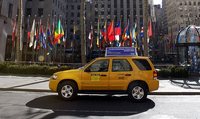Hybrid Cabs Take A Licking...But Their Meters Keep On Ticking
NEW YORK - April 20, 2006: The mean streets of San Francisco and New York City are the supreme torture test for any vehicle, let alone a new addition to those cities’ taxi fleets in February 2005 and last November, respectively.
So there was good reason for concern among drivers, cab owners and taxi commissions when the first mini-fleets of Escape Hybrid taxis hit the road. Among them:
Will these off-the-rack, gas-electric sport utilities be able to go where the traditional, full-size sedan cabs with their reinforced suspensions and heavy-duty radiators have gone since the early 20th century — up and down the steep, pot-holed San Francisco hills that only a triathlete could love, and through the legendary Manhattan congestion — 24/7 shift after 24/7 shift? Will the new nickel-plated hydride batteries really survive their 100,000-mile warrantees? Will cab companies and their drivers save enough on fuel to make up for the roughly $4,000 premium purchase cost of the hybrids? And will their fares be willing to trade off a couple of inches of legroom for going green?
So far, so good, say cab company owners, drivers and the taxi commissioners in both cities.
As the 30 San Francisco Escape Hybrid taxis are beginning to hit the 100,000-mile milestone, owners and drivers report:
 |
Fuel savings between $20 and $31 over the traditional, full-size sedan cabs per 150- to 300-mile shifts. Air conditioning cost on hot days: $5 a shift, about half the sedan-version cost. Brakes are lasting twice as long. The reason: The electric engine acts as a second braking system, taking much of the load off the conventional friction brakes, says Tom Watson, Ford Hybrid Electric Vehicle Propulsion System engineering manager, Sustainable Mobility Technologies and Hybrid Programs. Several water pumps blew at the 50,000-mile mark, a situation that’s been rectified, say Watson and San Francisco cab company owners. No legroom complaints from customers, who seem delighted by the novelty of the hybrid and by doing the right thing for the planet.
“Everybody wants to drive them,” says Hal Mellegard, general manager of Yellow Cab, which has 23 Escape Hybrid taxis in its fleet. “For the company, it’s strictly good PR, but it’s money in the drivers’ pockets since they pay for their own gas.”
John Lazar, president of Luxor Cab, which owns seven Escape Hybrid vehicles, also is pleased: “Drivers love ’em. They’re burning about a third of the fuel they used to.”
“It’s nice to have an SUV that does so well environmentally and saves me about $5,000 a year,” adds Allen Gotschberg, a Luxor driver who just rolled over 102,000 miles on his Escape Hybrid taxi.
Both cab companies report they’ll wait until the cabs have 125,000 to 150,000 miles on them before making final judgment on the new genre, but the city’s goal is to have half its taxi fleet powered by cleaner-energy sources — hybrids and compressed natural gas — by 2008, says Heidi Machen, San Francisco taxi commissioner.
In New York, it’s too soon to tell the full benefits of the hybrid taxis, but they’ve already proven to be popular with cabbies and their customers, says Matthew W. Daus, head of the city’s Taxi and Limousine Commission.
“Everybody is most definitely enjoying the green benefits of the hybrids,” he says. “And drivers are reporting larger tips because of the environmental and novelty aspects.”
Getting the first hybrid cabs onto the streets of New York was a joint effort among the City Council, the taxi commission, and community and environmental groups.
“We’re proud of our partnership to improve air quality, reduce dependency on foreign oil and improve the health of New Yorkers while putting more money back into the pockets of the drivers,” says Jack Hidary, chairman of SmartTransportation.org, an environmental advocacy group based in New York.
Hidary’s group is literally taking the hybrid campaign to the streets of other big cab cities such as Las Vegas and Chicago. Ford is also working with the city of Chicago to put hybrids into service as taxis beginning in 2007.



